Investigation of Failure Mechanisms in Oil-Lubricated Rolling Bearings under Small Oscillating Movements: Experimental Results, Analysis and Comparison with Theoretical Models
Abstract
:1. Introduction
1.1. Motivation and State-of-the-Art
1.1.1. Approach by Harris—Method 1
1.1.2. Approach by Harris and Rumbarger—Method 2
1.1.3. Approach by Houpert
1.1.4. Approach with an Equivalent Speed n
1.2. Research Objective of This Paper
2. Materials and Methods
2.1. Experimental Setup
2.2. Test Procedure, Plan, and Analysis
3. Results
3.1. Rating Life Tests RV 1 to SV 3
3.2. Check #1 with Deep Groove Ball Bearings: Is Tilting the Cause of the Damage?
3.3. Check #2: Is the Damage Still Present at Lower Hertzian Pressures?
4. Discussion
Author Contributions
Funding
Data Availability Statement
Acknowledgments
Conflicts of Interest
References
- Schwack, F.; Halmos, F.; Stammler, M.; Poll, G.; Glavatskih, S. Wear in wind turbine pitch bearings—A comparative design study. Wind Energy 2021, 25, 700–718. [Google Scholar] [CrossRef]
- Behnke, K.; Schleich, F. Exploring limiting factors of wear in pitch bearings of wind turbines with real-scale tests. Wind Energy Sci. 2023, 8, 289–301. [Google Scholar] [CrossRef]
- Tawresey, J.S.; Shugarts, W.W. An Experimental Investigation of the Fatigue Life and Limit Load Characteristics of Needle Roller Bearings Under Oscillating Load Conditions. Available online: https://apps.dtic.mil/sti/citations/AD0437467 (accessed on 30 April 2024).
- Rumbarger, J.H.; Jones, A.B. Dynamic Capacity of Oscillating Rolling Element Bearings. J. Lubr. Tech. 1968, 90, 130–138. [Google Scholar] [CrossRef]
- Harris, T.A.; Kotzalas, M.N. Rolling Bearing Analysis. In Essential Concepts of Bearing Technology, 5th ed.; CRC Press: Boca Raton, FL, USA, 2007. [Google Scholar]
- Harris, T.A.; Rumbarger, J.H.; Butterfield, C.P. Wind Turbine Design Guideline DG03: Yaw and Pitch Rolling Bearing Life; Technical Report NREL/TP-500-42362; NREL: Golden, CO, USA, 2009. [Google Scholar] [CrossRef]
- Houpert, L. Bearing Life Calculation in Oscillatory Applications. Tribol. Trans. 1999, 42, 136–143. [Google Scholar]
- DIN ISO 281; Wälzlager—Dynamische Tragzahlen und nominelle Lebensdauer. Beuth: Berlin, Germany, 2010.
- Menck, O.; Stammler, M. Review of rolling contact fatigue life calculation for oscillating bearings and application-dependent recommendations for use. WES 2024, 9, 777–789. [Google Scholar] [CrossRef]
- Houpert, L.; Menck, O. Bearing Life Calculations in Rotating and Oscillating Applications. J. Tribol. 2022, 144, 071601-1–071601-18. [Google Scholar] [CrossRef]
- Breslau, G.; Schlecht, B. A Fatigue Life Model for Roller Bearings in Oscillatory Applications. In FVA (Hrsg.): Bearing World Journal Nr. 5, 1st ed.; VDMA: Frankfurt am Main, Germany, 2020; pp. 65–80. [Google Scholar]
- Schwack, F.; Bader, N.; Leckner, J.; Demaille, C.; Poll, G. A study of grease lubricants under turbine pitch bearing conditions. Wear 2020, 454–455, 203335. [Google Scholar] [CrossRef]
- Wandel, S.; Bader, N.; Glodowski, J.; Lehnhardt, B.; Leckner, J.; Schwack, F.; Poll, G. Starvation and Re-lubrication in Oscillating Bearings: Influence of Grease Parameters. Triology Lett. 2022, 70, 114. [Google Scholar] [CrossRef]
- Cavacece, F.; Frache, L.; Tonazzi, D.; Bouscharain, N.; Philippon, D.; Le Jeune, G.; Maheo, Y.; Massi, F. Roller bearing under high loaded oscillations: Life evolution and accommodation mechanisms. Tribol. Int. 2020, 147, 106278. [Google Scholar] [CrossRef]
- FVA AB 824 I; Ermüdungslebensdauer von Wälzlagern unter Kleinen Schwenkbewegungen. FVA: Frankfurt, Germany, 2021.
- Halmos, F.; Bartz, M.; Wartzack, S. Schadens-und Ausfallmechanismen bei Wälzlagern unter Schwenkbewegungen. In Gleit-und Wälzlagerungen 2023; VDI Verlag: Düsseldorf, Germany, 2023; Volume 2415, pp. 321–332. [Google Scholar] [CrossRef]

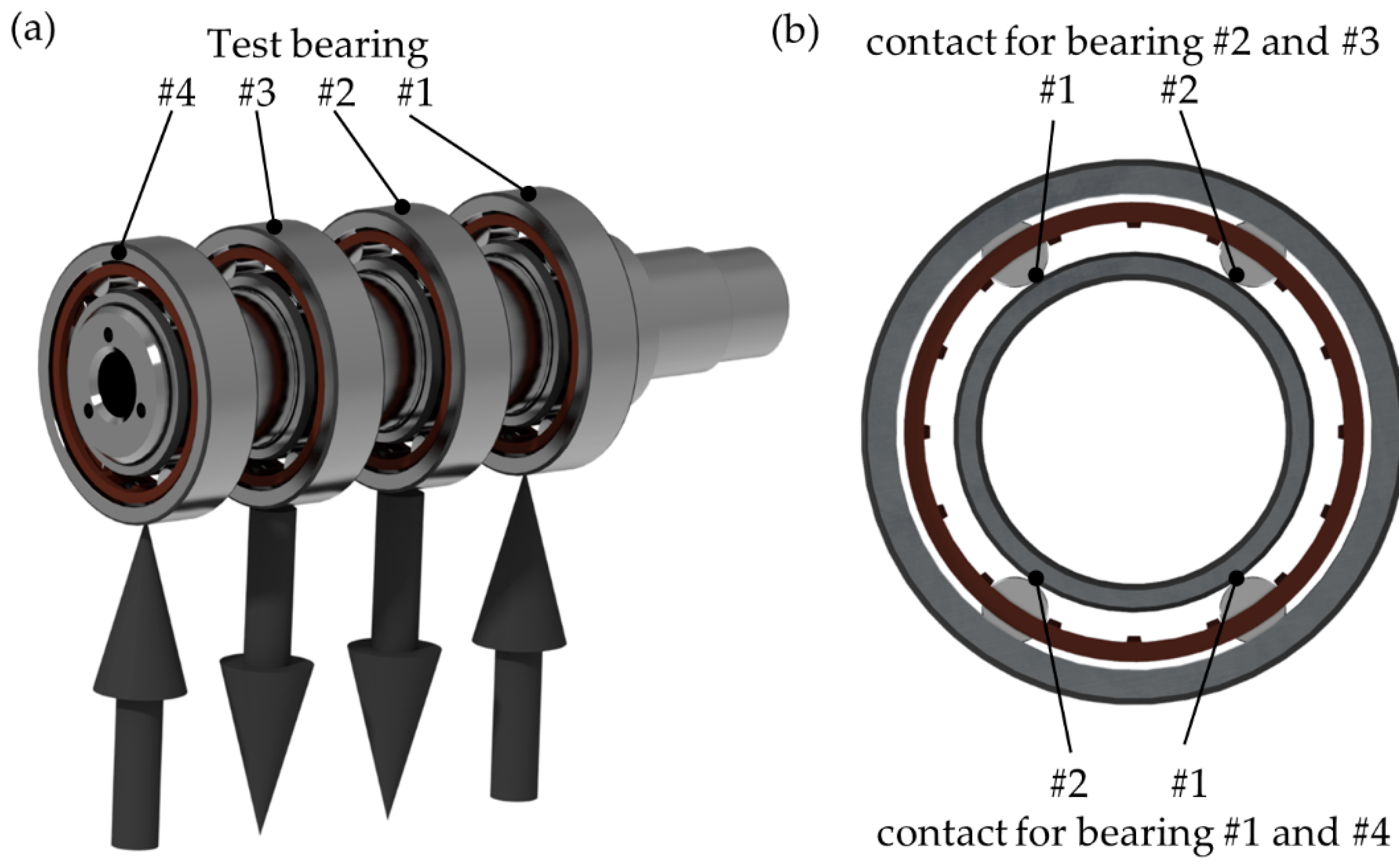
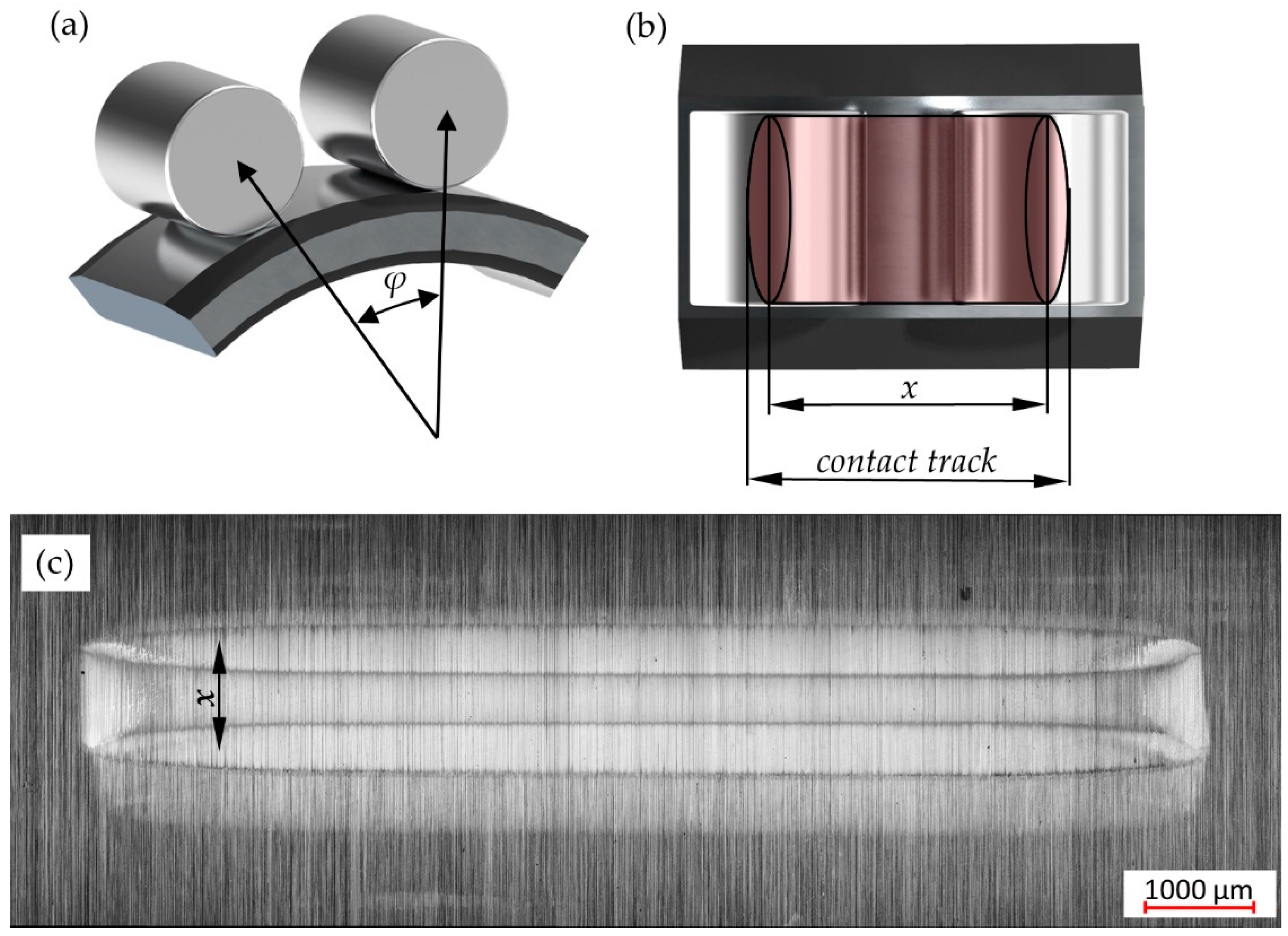

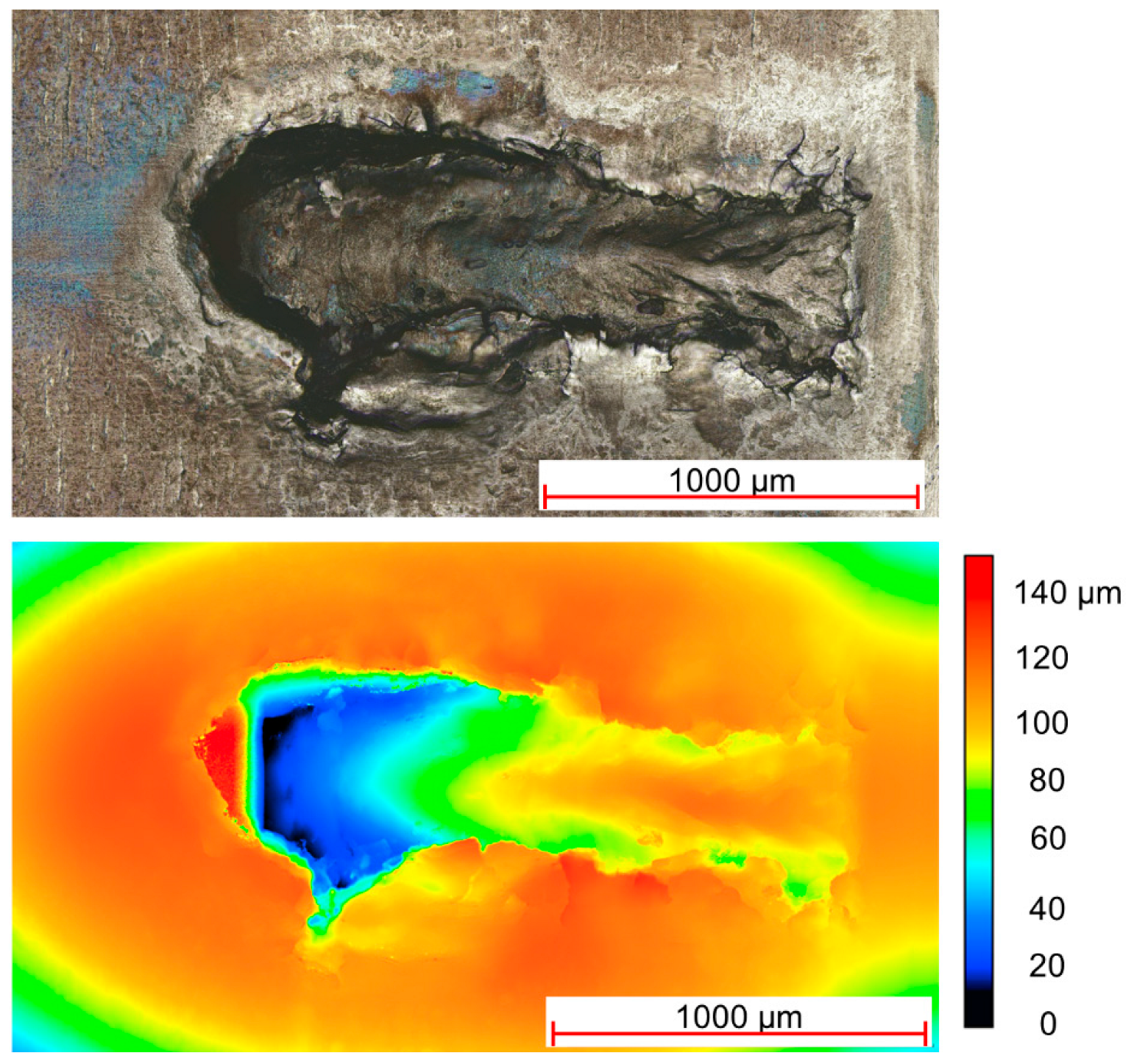
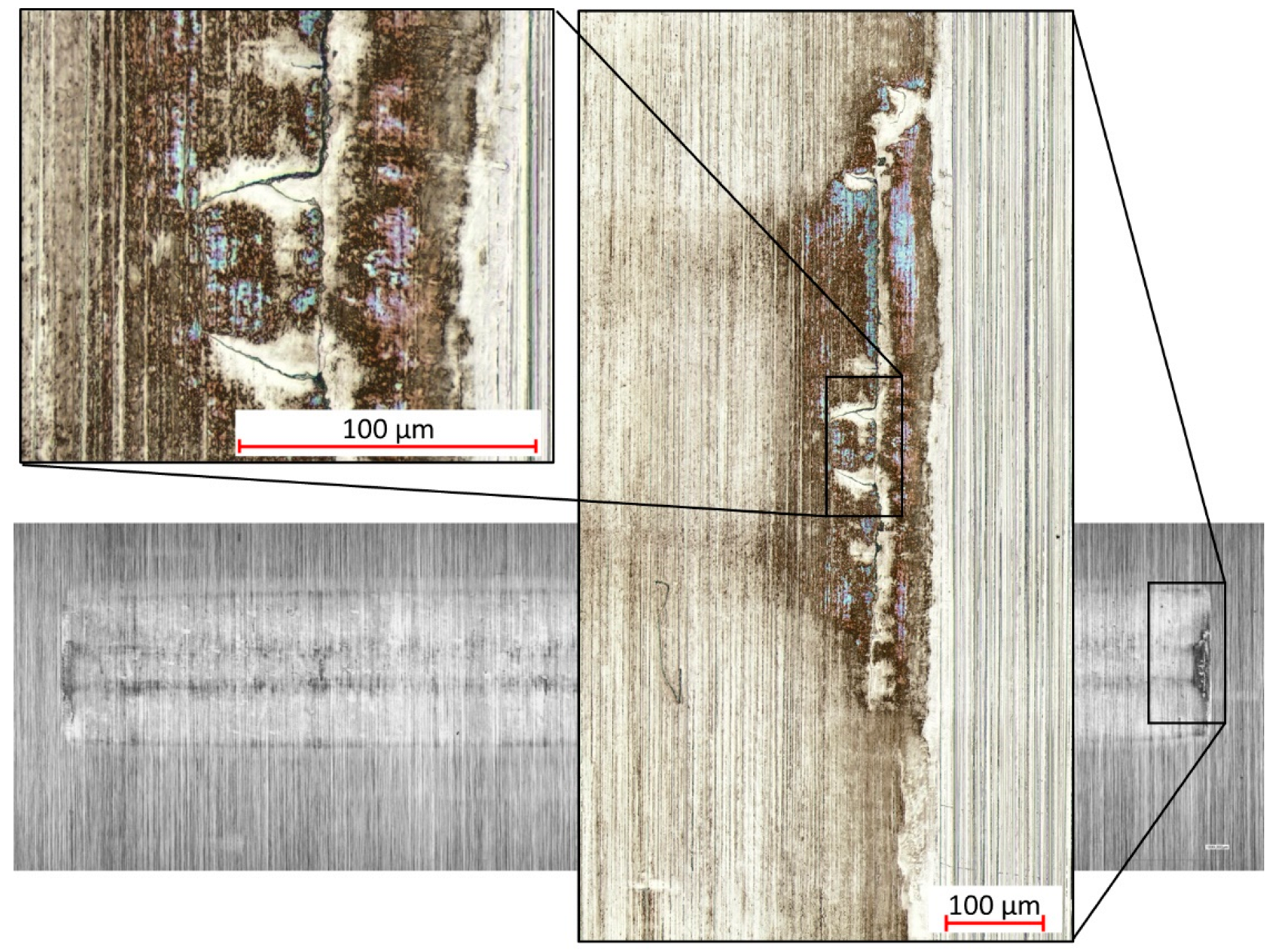

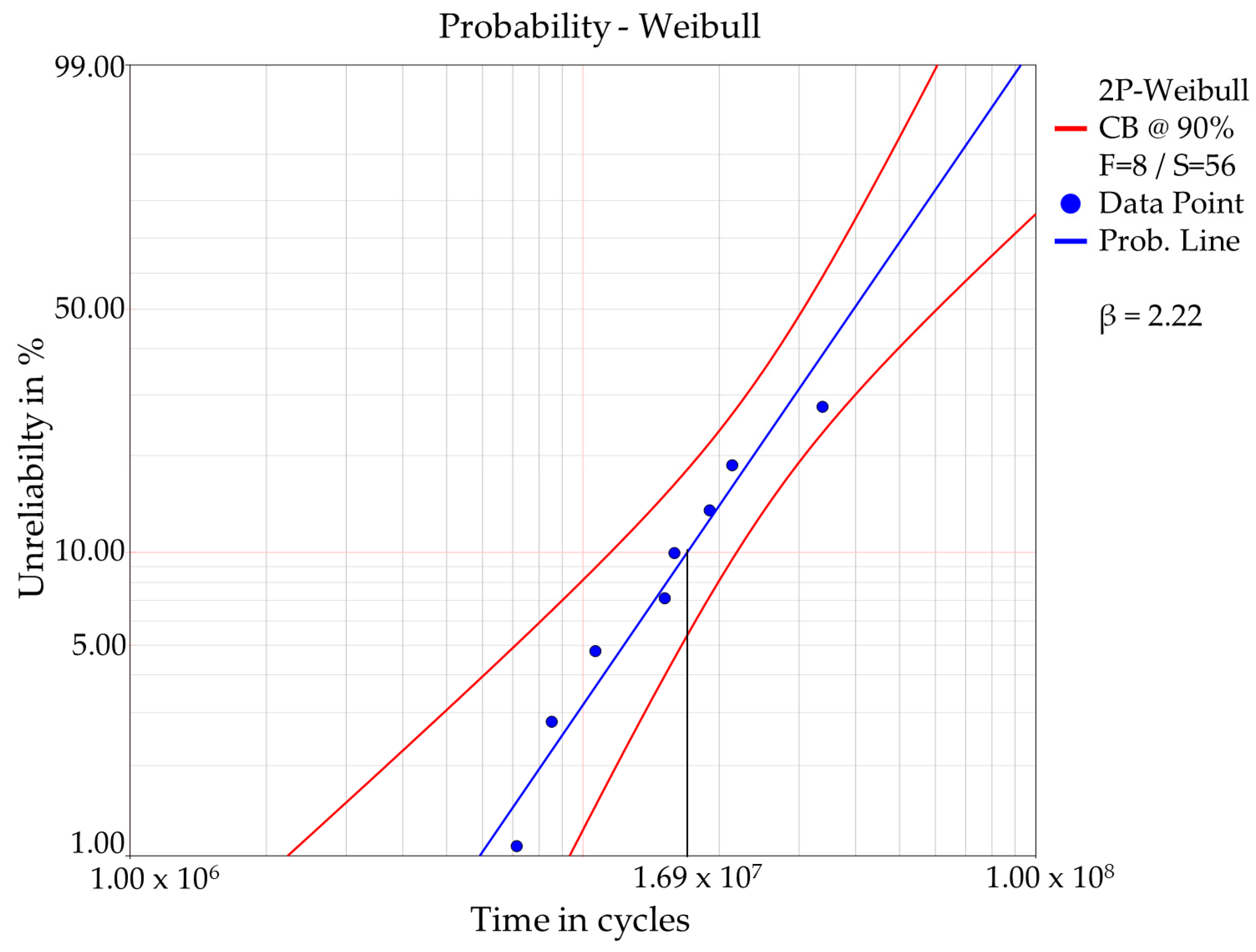
| Pitch diameter Dpw | 70.48 mm |
| Rolling element diameter Dwe | 10.98 mm |
| Rolling element length l | 11.4 mm |
| Number of rolling elements Z | 1 (for calculation) |
| Dynamic load capacity Cr | 8.46 kN |
| Oscillation angle φ | 3° |
| Oscillation frequency | 10 Hz |
| Oscillation path x IR | 0.779 mm |
| x/2b IR | 1.91 |
| Name | ZRL/DGB | Hertzian Pressure in MPa | Number of Oscillation Cycles | Failure at IR or OR | Manufacturer |
|---|---|---|---|---|---|
| RV1 | CRB | 3000 | 8,968,438 | OR 3_1 | A |
| RV2 | CRB | 3000 | 21,893,705 | OR 3_1 | A |
| RV3 | CRB | 3000 | 16,436,337 | OR 3_1 | A |
| RV4 | CRB | 3000 | 15,796,133 | OR 4_1 | A |
| RV5 | CRB | 3000 | 19,427,977 | OR 3_1 | A |
| SV1 | CRB | 3000 | 34,209,108 | IR 2_2 | B |
| SV2 | CRB | 3000 | 11,170,668 | IR 3_1 | B |
| SV3 | CRB | 3000 | 7,653,117 | IR 2_2 | B |
| AV1 | CRB | 2500 | 24,300,000 | - | B |
| AV2 | CRB | 2500 | 23,900,000 | OR 1_1 | B |
| AV3 | CRB | 2500 | 43,000,000 | - | B |
| AV4 | CRB | 2500 | 47,000,000 | - | B |
| RV1 | DGB | 3000 | 15,280,000 | IR 2_1 | B |
Disclaimer/Publisher’s Note: The statements, opinions and data contained in all publications are solely those of the individual author(s) and contributor(s) and not of MDPI and/or the editor(s). MDPI and/or the editor(s) disclaim responsibility for any injury to people or property resulting from any ideas, methods, instructions or products referred to in the content. |
© 2024 by the authors. Licensee MDPI, Basel, Switzerland. This article is an open access article distributed under the terms and conditions of the Creative Commons Attribution (CC BY) license (https://creativecommons.org/licenses/by/4.0/).
Share and Cite
Halmos, F.; Wartzack, S.; Bartz, M. Investigation of Failure Mechanisms in Oil-Lubricated Rolling Bearings under Small Oscillating Movements: Experimental Results, Analysis and Comparison with Theoretical Models. Lubricants 2024, 12, 271. https://doi.org/10.3390/lubricants12080271
Halmos F, Wartzack S, Bartz M. Investigation of Failure Mechanisms in Oil-Lubricated Rolling Bearings under Small Oscillating Movements: Experimental Results, Analysis and Comparison with Theoretical Models. Lubricants. 2024; 12(8):271. https://doi.org/10.3390/lubricants12080271
Chicago/Turabian StyleHalmos, Fabian, Sandro Wartzack, and Marcel Bartz. 2024. "Investigation of Failure Mechanisms in Oil-Lubricated Rolling Bearings under Small Oscillating Movements: Experimental Results, Analysis and Comparison with Theoretical Models" Lubricants 12, no. 8: 271. https://doi.org/10.3390/lubricants12080271
APA StyleHalmos, F., Wartzack, S., & Bartz, M. (2024). Investigation of Failure Mechanisms in Oil-Lubricated Rolling Bearings under Small Oscillating Movements: Experimental Results, Analysis and Comparison with Theoretical Models. Lubricants, 12(8), 271. https://doi.org/10.3390/lubricants12080271





